Key takeaways:
- Nutrition education enhances overall well-being, especially for individuals facing food insecurity, by empowering them to make informed choices.
- Participants in nutrition programs often experience transformative moments, realizing the importance of balanced meals for health and vitality.
- Challenges in accessing nutritious food for homeless individuals include a lack of knowledge and limited availability of healthy options.
- Effective nutrition education strategies involve hands-on activities, collaboration, and providing practical resources to increase understanding and engagement.
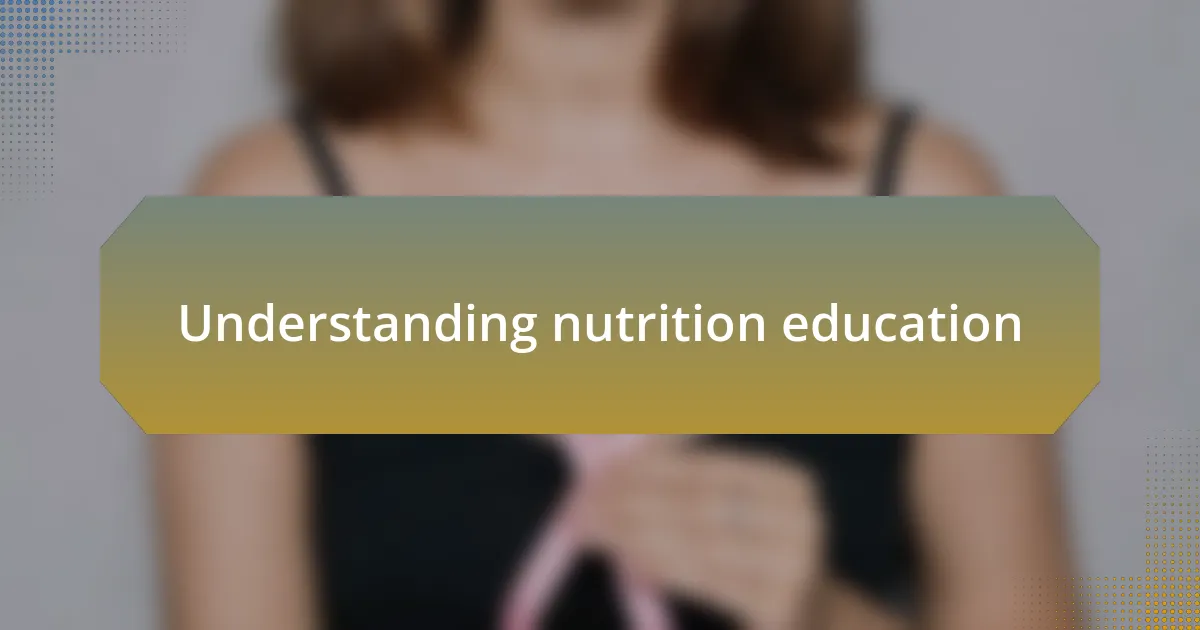
Understanding nutrition education
Nutrition education is not just about food; it’s about understanding the role of nutrition in overall well-being. I remember a moment when I was volunteering at a community kitchen, and I witnessed individuals prioritizing filling their stomachs over making healthier choices. This experience opened my eyes to how crucial it is to educate people on the long-term benefits of nutrition.
Many may wonder, why does it matter what we eat? I often found myself pondering this question when speaking with individuals experiencing homelessness. For many, the immediate need is survival, but I learned that providing education on making nutritious choices can spark a desire for better health. It’s empowering to realize that knowledge can inspire change—even in the toughest circumstances.
Through these interactions, I’ve come to appreciate that nutrition education can be a game changer. It’s emotional to see someone realize they can improve their situation simply by understanding what constitutes a balanced meal. This awareness not only fosters healthier eating habits but also promotes a sense of agency and dignity, reminding us all that we have the power to make choices that affect our health positively.
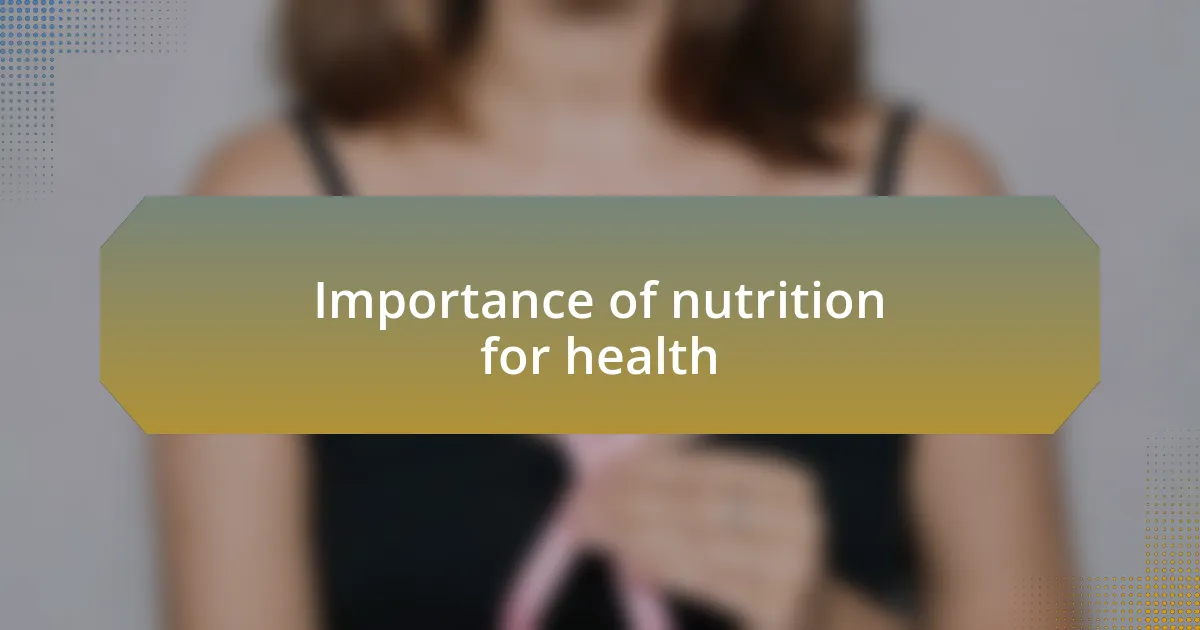
Importance of nutrition for health
Nutrition plays a vital role in maintaining our health, especially for those facing challenging circumstances. I remember a conversation I had with a young woman struggling with homelessness. She expressed fatigue and constant illness, which prompted me to share insights about how essential nutrients could boost her immune system. It was a revelation for her; suddenly, food wasn’t just a means to fill her belly, but a tool for survival and vitality.
The connection between what we eat and how we feel is profound. I often ask myself and others: “Have you ever noticed how a nutritious meal can uplift your mood?” When we nourish our bodies with whole foods, we not only fuel physical health but also improve mental well-being. I once prepared a simple meal packed with vegetables for a group at a shelter, and the smiles on their faces afterwards showed me that nutrition does more than just sustain life—it brings joy, energy, and hope.
For someone facing food insecurity, understanding nutrition can transform their outlook on life. During one outreach event, I had the chance to see someone’s eyes light up as they learned about the benefits of protein and fiber. It was a small moment, but it created a ripple effect, sparking discussions about meal planning and healthy eating. When I reflect on that experience, I’m reminded of how education around nutrition can empower individuals to take charge of their health, promoting not just survival, but a quality of life that everyone deserves.
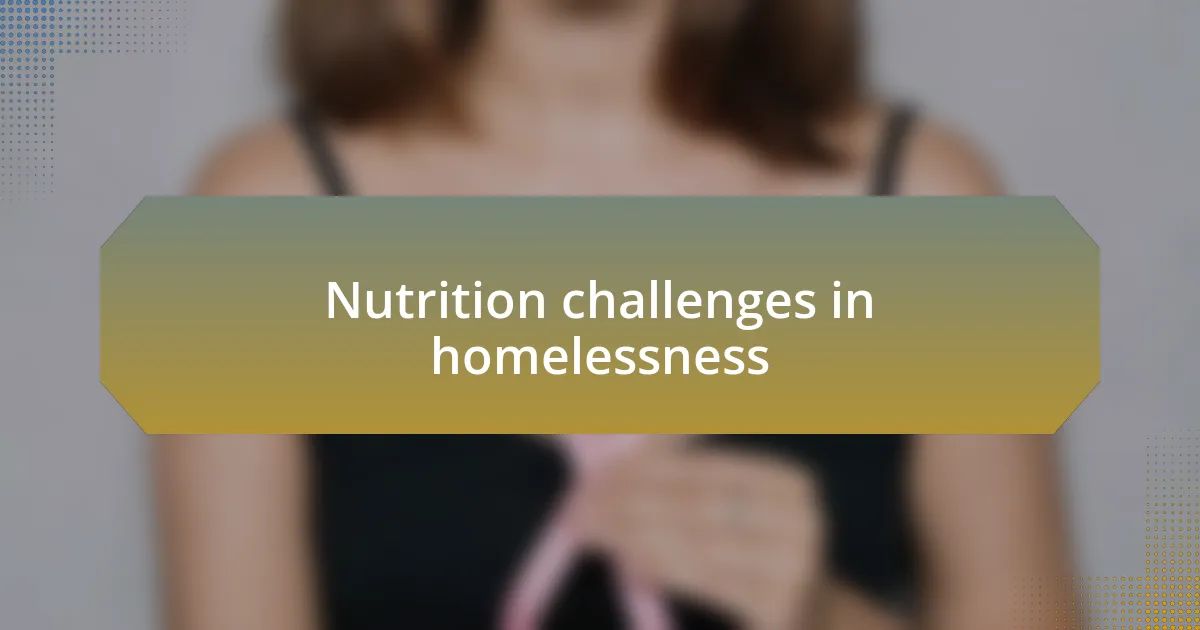
Nutrition challenges in homelessness
Nutrition challenges in homelessness are often multifaceted and deeply rooted in socioeconomic issues. I once met a man named Peter at a local shelter who shared his struggles with accessing nutritious food. He pointed out that many food banks primarily provide canned goods and processed items, which lack essential nutrients. This experience made me wonder: if healthy options are scarce, how can we expect individuals to maintain their health?
Another significant challenge is the lack of knowledge regarding nutrition. During a community workshop, I noticed that many attendees felt overwhelmed by information about healthy eating. A woman raised her hand and asked, “How am I supposed to make good choices when I don’t even know what healthy options are?” Her question struck a chord with me. It highlighted a gap in education and access that many face daily—an obstacle that can feel insurmountable.
The environment surrounding individuals experiencing homelessness can exacerbate these challenges. Often, I have seen people resort to fast food out of convenience, simply because it’s more accessible than a fresh produce market. In one instance, I accompanied a group on a grocery outing to a local market, and there was a palpable excitement when they selected fruits and veggies for the first time. It reminded me that the simple act of choosing food can be a powerful statement of agency and health; it’s an opportunity that should be available to everyone, regardless of their circumstances.
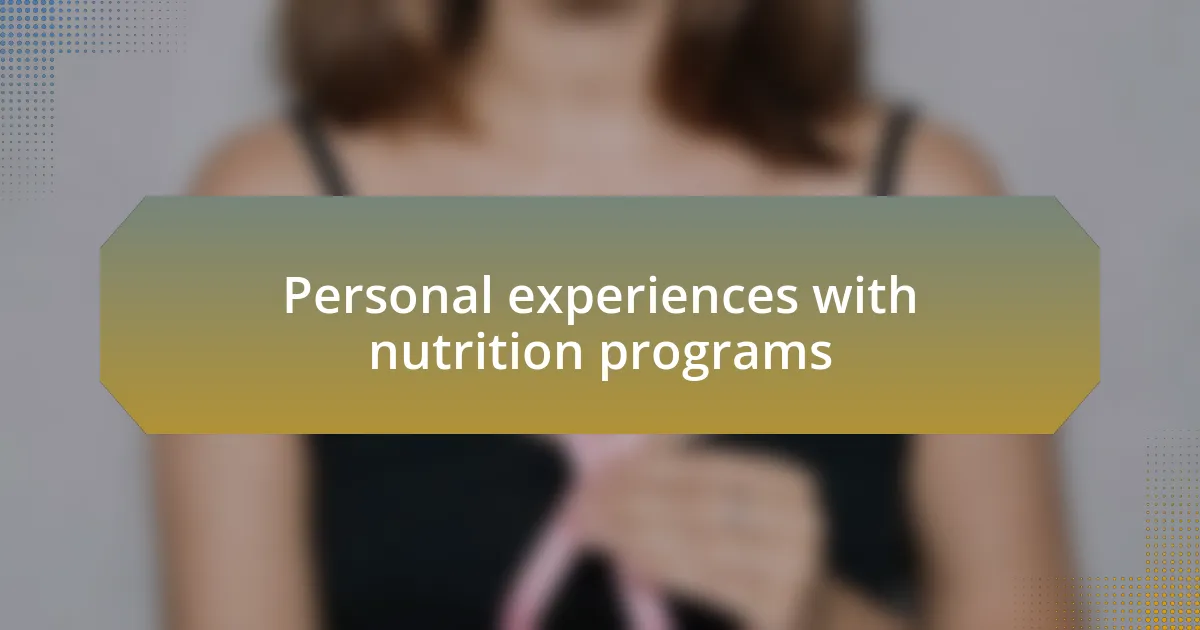
Personal experiences with nutrition programs
I’ve had the privilege of volunteering with nutrition programs aimed at individuals facing homelessness, and let me tell you, the impact can be transformative. I remember a day when we prepared a healthy cooking class. The looks on the participants’ faces when they learned to make a simple vegetable stir-fry were priceless. It was more than just cooking; it was about empowering them with skills that could lead to healthier choices in everyday life.
In another experience, I worked with a nutritionist who provided one-on-one guidance to participants. I witnessed a young woman named Sara struggle to understand portion sizes. She expressed frustration, saying, “I never knew how much I should be eating.” It struck me how vital it is to simplify nutrition information so that it resonates with people where they are. Addressing these questions not only builds knowledge but also fosters a sense of confidence in their ability to make better food choices.
Moreover, participating in these programs has shown me the joy of community. During a meal-sharing event, I noticed how discussions about favorite recipes sparked connections among attendees. People smiled, exchanged ideas, and for a moment, the weight of their circumstances seemed lighter. This connection around food can be a profound reminder: sharing knowledge and experiences can turn nutrition education into a supportive lifeline. Isn’t that what everyone deserves—to feel supported and empowered in their health journey?
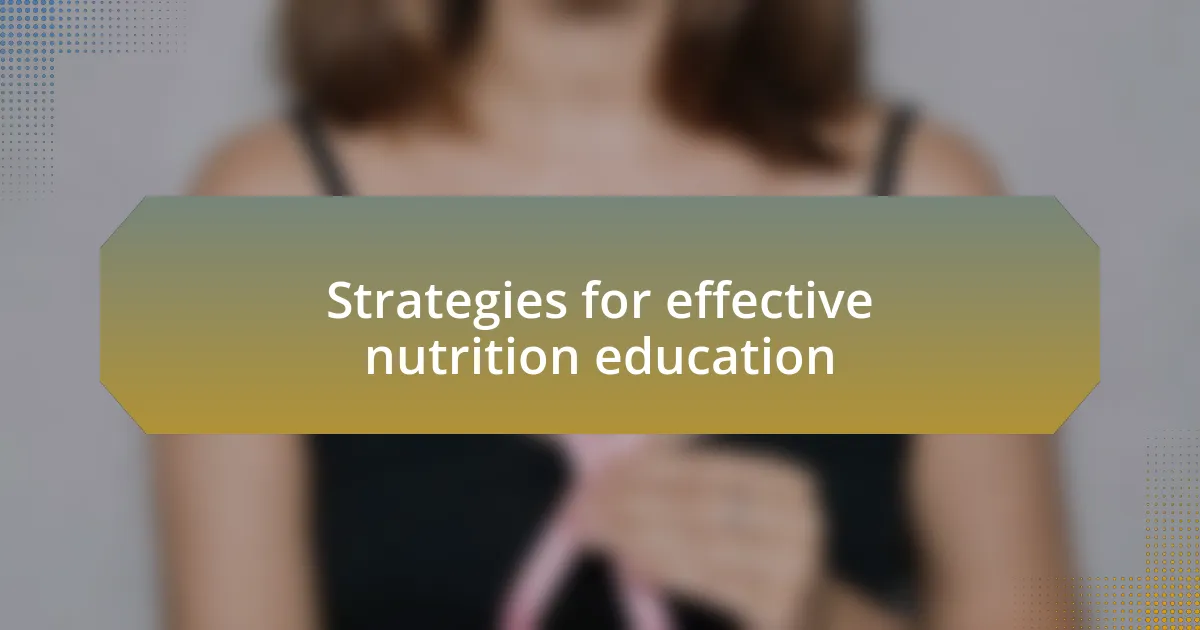
Strategies for effective nutrition education
Using hands-on activities is one of the most effective strategies for nutrition education. I recall a workshop where we transformed a simple grocery shopping trip into a teaching moment. Participants were engaged as we compared labels and budgeted for meals. Seeing the lightbulb moments when they realized they could make healthy choices within their limited means was incredibly rewarding.
Creating a collaborative environment is also crucial. I remember hosting a series of group discussions where attendees shared their favorite healthy recipes. It was eye-opening to see how sharing personal experiences made the information more relatable and memorable. It emphasizes that they’re not alone in their journey, reminding everyone that every small change counts. How can we foster this sense of community in all aspects of nutrition education?
Additionally, providing resources that are both practical and accessible can greatly enhance understanding. During one session, we passed out simple, visually appealing handouts filled with easy recipes and budget tips. I noticed that many participants kept these resources handy, using them in their daily lives. It highlighted for me that when information is presented in a straightforward manner, we increase the chances of it being utilized. Isn’t it fascinating how simple strategies can lead to lasting change?
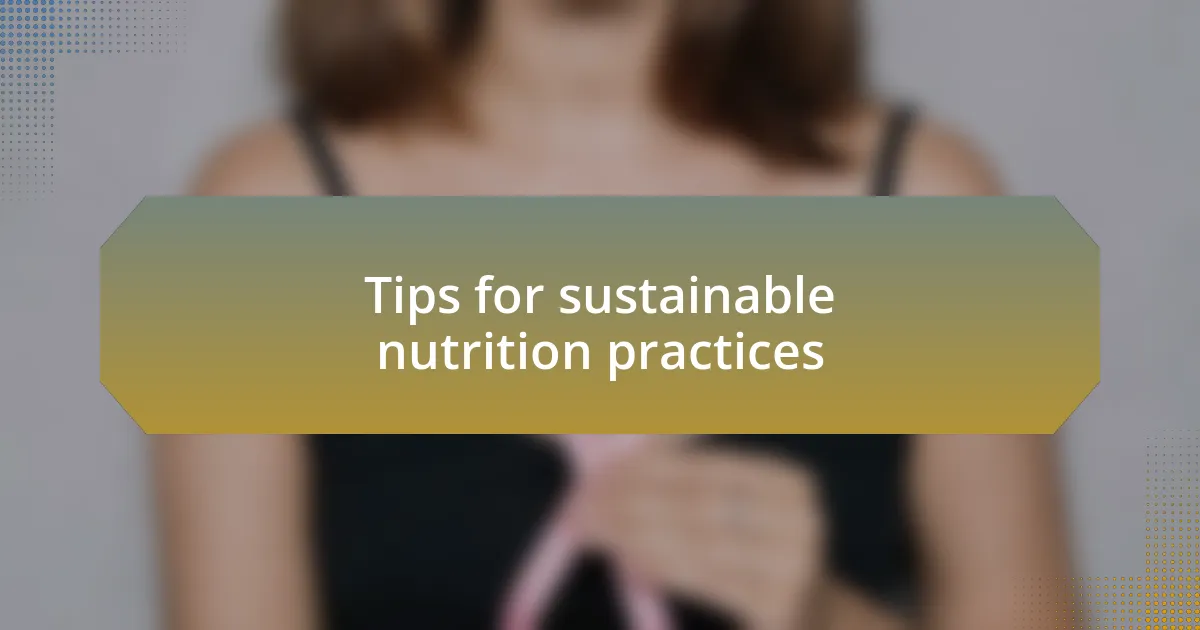
Tips for sustainable nutrition practices
Sustainable nutrition practices start with planning and utilizing what you have. I remember one time, I went through my pantry and found a collection of canned goods that had been sitting there untouched. By crafting meals around those items, I not only reduced waste but discovered new, delicious combinations. Have you ever considered how much food you might have that could easily be transformed into a meal?
Another tip is to focus on seasonal and local produce. When I began visiting farmers’ markets, I was amazed at the freshness and quality of the fruits and vegetables available. Not only do they taste better, but buying local supports the community and reduces the carbon footprint of transporting food long distances. Have you tried exploring local markets in your area? You might be surprised by what you find.
Lastly, consider learning to cook from scratch. I recall the first time I made my own bread; it felt like an accomplishment and gave me a deeper appreciation for food. Cooking at home often leads to healthier choices while minimizing packaging waste. It can also be a rewarding experience to get the entire family involved. What if cooking became not just nourishment, but a way to connect with those we love?